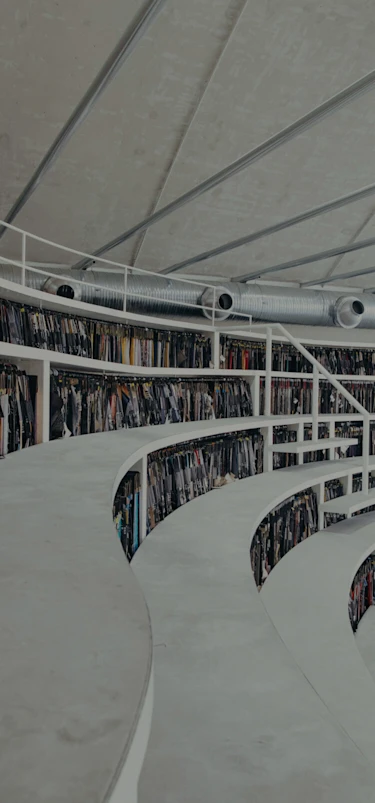F2
Fashion
December 7, 2022
Natural Beauty
How a modest Italian textile manufacturer called Manteco, in operation since the 1940s, has positioned itself to influence the future of circular fashion.
Words by Mary Holland
Photos courtesy Archivio Manteco
It was in 1943 that Marco Mantellassi's grandfather launched Manteco in Prato, Italy, out of necessity. The war was devastating the country, leaving it isolated and with no access to raw materials, except for a surplus of high-quality wool blankets and military garments. Enzo Anacleto Mantalessi saw a solution: to spin these threads into fibers that could be reused to create new textiles.
Eighty years later, Manteco still uses chemical-free processes to spin threads as a replacement for virgin fibers. The company has grown significantly, there's two co-CEOs (Enzo's grandsons) and new processes and materials have been innovated. And once again, Manteco finds itself at the forefront of a new necessity in clothing.
The fashion industry is at a critical point. The facts are clear: More than 8% of global greenhouse gas emissions come from the apparel and footwear industries, it's the second-biggest consumer of water and is responsible for 2% to 8% of global carbon emissions, according to the UN Alliance for Sustainable Fashion. Worse still is the increase in the purchase of clothes. The U.N. found that the average consumer buys 60%more pieces of clothing than they did 15 years ago. Each item is kept for only half as long, and every year more than 11.3 million tons of textile waste is disposed of in American landfills. Only 13% of textiles get recycled.
By 2025, two-thirds of the world's population may face water shortages, (according to the World Wildlife Fund), this will partly be because of textile production. For a mostly unregulated industry, where shoppers don’t have access to the most basic information, like transparency and traceability of garments, the uphill climb to improvement can feel insurmountable.

Archivio Manteco in Montemurlo, Italy
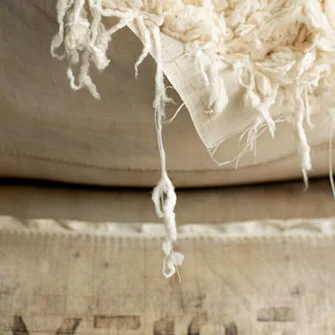
Virgin wool fibers in the Manteco warehouse
While many brands are lagging, there is some progress. A wave of savvy suppliers are supporting fashion houses by investing in a circular economy through take-back programs and by innovating new fibers in more responsible ways. By providing luxury and fast-fashion brands access to innovative textiles and deadstock fabrics, there's mounting pressure on brands to buckle to the industry’s most important new trend. These textiles could be game-changing, and already there have been some early adopters.
Danish cult brand Ganni, known for its forward-thinking approach to responsible fashion, has been collaborating with various innovative textile brands (including Manteco), even though it's not immediately favorable for their bottom line. “You need to partner with fabric innovators to help them mature and scale their offerings,” says Nicolaj Reffstrup, founder of Ganni. “This requires investments without an immediate ROI, and as such — and this goes for anything that pertains to responsibility — you need to anchor your ambitions to your shareholders. Without their support there will be no profound progress,” he adds.
Manteco is proving luxury fabrics don't have to be produced from virgin fibers and has created a system where old cashmere and wool threads can be recycled into raw materials. Today, the need for this is arguably even more critical than when the company started out. “We have always relied on our heritage, but we have also kept an eye to the future. Research and innovation are key parts of our DNA, just like a circular economy and a sustainable approach,” says Marco Mantellassi, co-CEO. Though the luxury supplier is not a household name, most people will certainly have heard of the high-end brands it partners with (including LVMH and Kering Group).
Through low-impact mechanical processes (one of which uses no water) developed in their on-site innovation lab, Manteco creates wool and cashmere textiles from old garments and fabric scraps gathered in the U.S. and Europe; these get hand-sorted at the mill according to color and composition (no dyes or chemicals are used in any of Manteco's products). One of their main secondary wool fibers is MWool, a high-end recycled wool made from a combination of pre-consumer scraps and post-consumer garments. Beyond using old textiles that would otherwise be landfilled, the fiber has an incredibly low impact. As converting fiber into fabric can create carbon emissions, companies need not only look at how to create circular textiles, but carbon reduction through energy efficiency. For a forward-thinking company like Manteco, this has long been a priority.
Through a life-cycle analysis report (with the Polytechnic University of Turin), Manteco was able to determine that 1 kilogram of MWool has a carbon footprint of 0.1 to 0.9 kilograms of CO2 equivalent (CO2eq), as opposed to virgin wool fibers, which release 10 to 103 kilograms of CO2eq. “We measure every single step of production and movement, defining the impact,” says Mantellassi. “We saw that this was saving 99% of water and energy.” Through their take-back programs (called Project 43 and Project 53) Manteco invites manufacturers to give back clothes or textile offcuts that haven't been used or sold. It's a service that's based on traceability. “We're giving brands the chance to solve a big problem, which is their unsold garments that cannot be repaired,” says Mantellassi, adding that the company is also committed to transparency and works closely with their clients, providing not only the fabrics and valuable guidance but labels with QR codes that help shoppers understand how the product was made, every step of the way. “We want to give companies the chance to provide customers with as much transparency and traceability as they can. It’s very important that it’s a vision we can share together,” says Mantellassi.
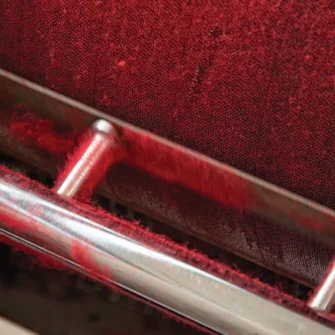
The shredding mill.
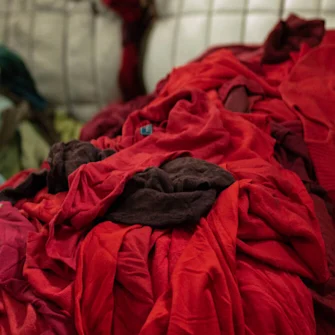
Post-consumer wool garments divided per color and composition.
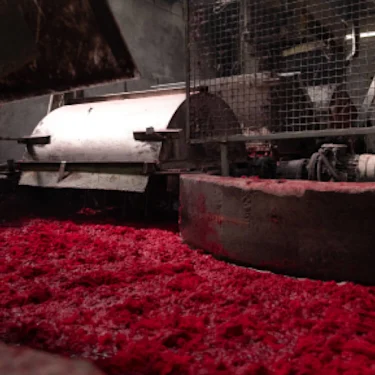
Post-consumer wool garments divided per color and composition
With traceability, not only are brands held accountable, but buyers can understand the path a garment takes before it winds up in their hands or on their doorstep, nudging them to make better choices. At Queen of Raw, an online marketplace for deadstock fabrics, the company is able to track and trace the lifecycle of textiles through innovative software and databases. Through the software, they’ve unlocked thousands of warehouses holding reels upon reels of deadstock fabric, while also automating an on-boarding process and centralizing everything in one place, in real time. “All we need is an email to add partners to the chain with immediate access to excess inventory globally,” says Stephanie Benedetto, CEO and founder of Queen of Raw. These are then easily linked to companies (including Fortune 500 enterprises) which can manage excess inventory across their supply chain. “For every product that passes through our exchange, we know what it’s made of, where it sits, who it ships to, whether it’s recycled, reused or sold. It also generates a QR code, so the buyer can see whether this is certified deadstock,” says Stephanie Benedetto, CEO and founder of Queen of Raw.
“This stuff traditionally gets landfilled or burned. So by keeping it in circulation and allowing brands to sell it and make money, there is an impact I can measure on the blockchain and report on,” says Benedetto, who has seen fashion companies also reuse the fabrics internally between in-house brands. And why wouldn’t they? When brands purchase deadstock fabric, not only does it skip the landfill, but ultimately the companies save money, too. Many of the textiles on the Queen of Raw exchange are high-end, valuable stock ideal for luxury brands, but Benedetto is determined to infiltrate the fast-fashion sector, too. “Unlike many people in the sustainability community, I have to and want to work with fast fashion. Of course they are a big part of the problem, but they are also a big part of the solution, and I can’t ignore them,” says Benedetto, whose company signed a white-paper solution with H&M and has more deals in the pipeline.
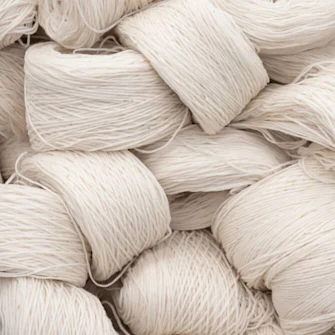
Virgin wool spinning scraps that will be reused
“It will require an adjustment for some companies’ business approaches, especially the ones that have been so focused on producing disposable goods or pushing people to buy lower-quality items that they’re wearing fewer times. It’s going to require a shift in all those approaches in order to get to where we need to go.”
Maxine Bédat Director of New Standard Institute
It’s true that fast-fashion brands are starting to follow suit, and this is thanks in part to companies that are producing more affordable, innovative fibers made from old threads. Renewcell is a Swedish company that produces a textile called Circulose®, developed through a process of dissolving pulp made of 100% recycled textiles, utilizing 100% renewable energy from Swedish hydropower. It was founded by an entrepreneur and two scientists, who discovered how to recover the cellulose from tattered high-cotton clothes that would otherwise go to landfills. The pulp offers an alternative to viscose fibers, usually produced from wood pulp, which requires almost double the resources, energy and water. Already the brand has worked with Zara, H&M and Levi’s, as well as fabric producers in Asia and Europe. By the end of this year, Renewcell will be producing at a commercial scale in its new factory: more than 120,000 tons of fabric per annum, all from textile waste.
Another new fiber made from post-consumer waste and textile waste is Infinited Fiber, which was founded in 2016 and already has two pilot sites in Finland. The fiber, called Infinna™, is made from textile waste that is made from 88% cotton, is collected and sorted, then goes through a six-step process — all fueled by renewable energy, which is readily available in Finland — before becoming Infinna™, which feels similar to cotton. The company is still in its pilot phase but has worked with H&M and has an agreement with Zara’s parent company Inditex for more than $100 million. Infinited Fiber has big visions to scale up the process by licensing the technology globally. Though they're currently focused on using high-cotton inputs, they say that the technology will also work with many other cellulose sources, like used newspapers and cardboard and even agricultural discards like rice and wheat straw.
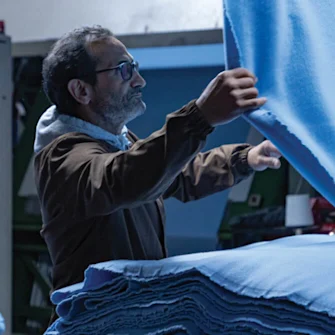
The warping of yarns at Manteco
Manteco has a few fast-fashion capsules in the pipeline and has collaborated with Zara, but an important pillar of the company is to produce long-lasting items.
“No matter whether something is recyclable or not, if it’s not durable, then you’re not going to get the sustainability you want. Sustainability is slow fashion because it’s something you keep in your closet. It’s something you pass on to your children,” says Mantellassi.
One of the company’s most recent innovations is VITA, their most durable fabric yet, which is held up against strict performance standards in pilling, abrasion resistance and tensile strength. “It’s five times stronger [than standard testing protocols],” says Mantellassi. “With VITA we can create quality that lasts for a long time.” And not just for fashion but in other areas like the automotive industry, too.
There’s a strong argument to be made that we should be investing in garments rather than obsessively consuming everything we see on Instagram, but we also have to be realistic. “Avoiding consumption will always be the most responsible choice; however, unfortunately, there’s nothing indicating that the industry growth is slowing. Fashion isn’t going away,” says Reffstrup.
Benedetto has the same thinking, in that only by acknowledging the realities of the industry can we tackle the issue. “Everybody in this community wants to talk about how we have to change consumption. And yes, we do, but if we want to solve this we’re not going to change consumption overnight. We have to meet consumers where they are. I’ve always said that we should keep waste in circulation longer and allow companies access to buying and selling deadstock. Yes, ultimately I want brands to have less waste, but I want to meet them all here,” she says. It’s also not entirely up to consumers. How can we expect people to know how their garments are produced if they can’t access basic information on traceability? “There’s a lot more education that needs to happen, but it’s also about recognizing that we can’t require individual consumers to get a Ph.D. in choosing a pair of jeans,” says Maxine Bédat, director of New Standard Institute, a non-profit that pushes for a more responsible fashion industry. “It really is a regulatory issue that needs to be solved. That’s what regulators should be doing; that’s their job.”
Much like the automotive industry, which has benefited from both preempting and adapting to increased regulation, Bédat sees fashion following a similar trajectory. For now, companies will need to take bold approaches and weigh up the ultimate environmental costs over short-term profit maximization.
“Behaving responsibly short-term will cost money, and there’s no immediate ROI,” says Reffstrup. “Hopefully, longer-term partnering with innovative materials suppliers will allow them to mature their offerings until they achieve commercial viability.” With suppliers offering more responsible options that make it easy for both luxury and low-end brands to pivot, excuses are running out.
“Leadership in companies would be wise to get ahead of these issues,” says Bédat. “Not just because it’s the right thing to do for their business but because it’s the right thing to do for society.” Now more than ever before, it’s a necessity. And companies like Manteco don’t see any other way. “It’s so important to reuse what we have already created,” says Mantellassi, with a sense of urgency in his voice. “Only through take-back programs can we try to save the planet.”
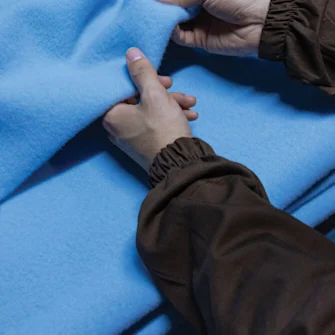
The warping of yarns at Manteco
“No matter whether something is recyclable or not, if it’s not durable, then you’re not going to get the sustainability you want. Sustainability is slow fashion because it’s something you keep in your closet. It’s something you pass on to your children”
